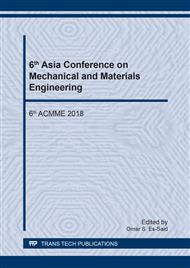p.159
p.165
p.170
p.176
p.181
p.189
p.194
p.200
p.206
Magnetic Citric Acid-Modified Cellulose for the Removal of Copper Ions from Aqueous Solution
Abstract:
Magnetic citric acid-modified cellulose was successfully produced and tested for the removal of copper in aqueous solution. Initially, the cellulose material was reacted with citric acid solution. The modified cellulose was then attached to the Fe2O3 nanoparticle producing an adsorptive magnetic material. Characterization using scanning electron microscopy (SEM) and Fourier transform infrared (FTIR) spectroscopy indicated successful binding and chemical modification of the cellulose. Its adsorption was also studied to evaluate its potential in removing heavy metals such as copper. Removal of copper was as high as 84.74% in solution containing 25 mg/L copper. The sorption of copper in the magnetic sorbent follows second-order kinetics and best fits Freundlich isotherm model. The developed material has a strong magnetic response, thus its recovery in the aqueous solution could be easily facilitated using a magnetic field. Regeneration study indicated high recovery efficiency maintaining above 95.7% copper removal efficiency after three cycles of use. Thus, a highly efficient magnetic adsorptive material was produced using simple chemical modification aside from its easy recovery in the water.
Info:
Periodical:
Pages:
181-186
Citation:
Online since:
October 2018
Keywords:
Price:
Сopyright:
© 2018 Trans Tech Publications Ltd. All Rights Reserved
Share:
Citation:


